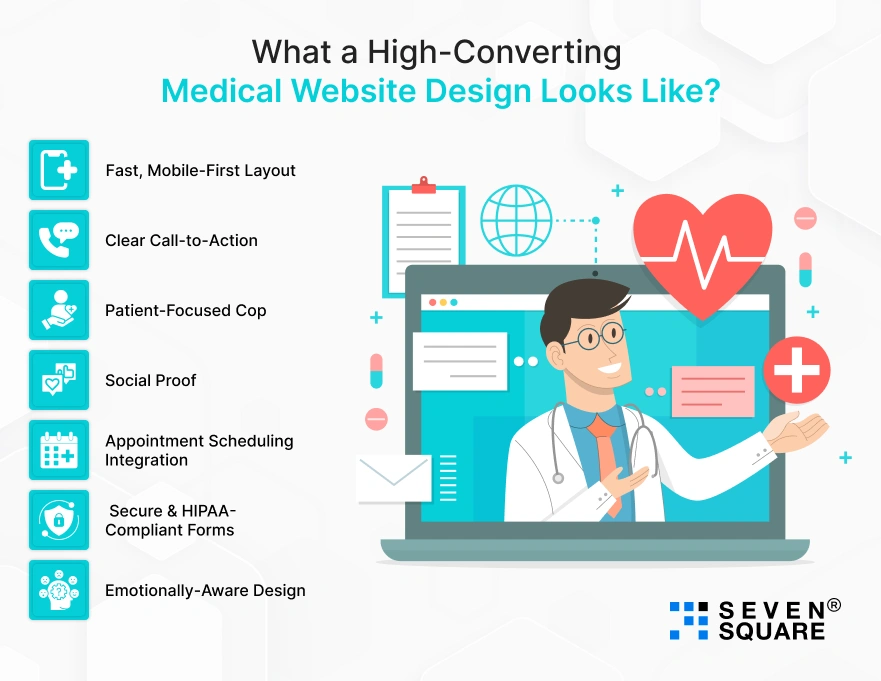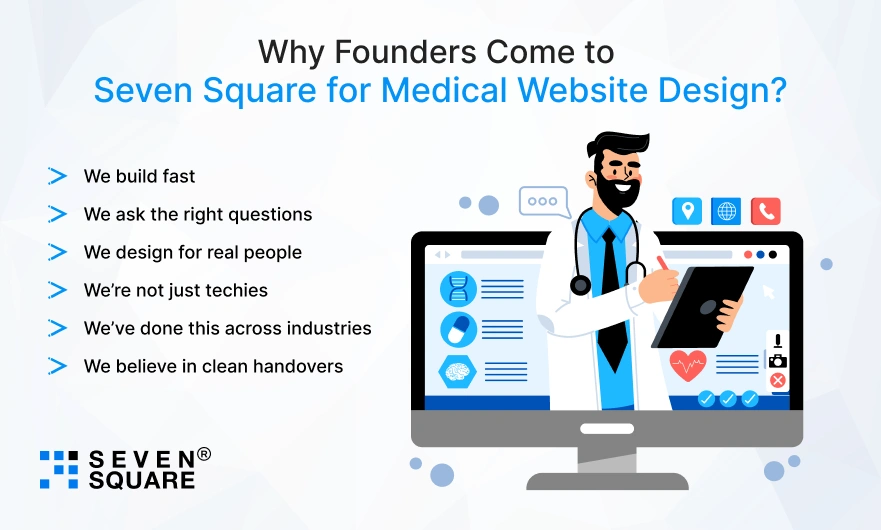“I think our website is turning people away.”
That’s what a clinic founder told us on a call last month. Their website was functional, but barely. It hadn’t changed in years. The fonts were outdated. The site loaded slowly.
It didn’t work well on mobile. Most importantly, it didn’t feel like a place patients could trust. And that’s the keyword: trust.
Your clinic’s website isn’t just a digital brochure. It’s your first handshake with a potential patient.
It’s what they check before booking an appointment or trusting you with their health.
If you’ve ever felt that your medical website design is holding you back, or if your traffic is decent but conversions are poor, then you’re not alone.
At Seven Square, we’ve helped clinics, hospitals, and healthcare startups completely transform how their websites work and feel.
If you are trying to learn about healthcare website design or want to do a clinic website redesign, then you are at the right place.
This blog explains the importance of medical website design and what you should avoid.
Why You Must Redesign an Outdated Clinic Website? (With Data to Back It Up)
Patients expect the same level of ease from your site as they do from apps like Zomato or Swiggy. If your website feels bulky, they’ll bounce.
- 94% of people say web design is the reason they mistrust or reject a site.
- 74% of patients research a medical provider’s website before making a decision.
- Mobile-first healthcare website design is now a ranking factor for Google.
So yes, your clinic website redesign is more than cosmetic. It’s functional. It’s strategic. And it directly impacts how many appointments you book.
Learn to build a Mental Health App.
Signs Your Healthcare Website Design Needs a Redesign
Let’s get brutally honest. If any of these apply to your current site, it’s time:
- It’s not mobile-friendly.
- It takes more than 3 seconds to load.
- It looks like it was built in 2020. (because it was)
- It’s missing online appointment booking.
- There’s no patient-focused storytelling or testimonials.
- You don’t feel proud when you look at it.
If you’re nodding your head, you’re not alone. Many clinics and hospitals start with the basics and then forget to evolve.
But the truth is: Modern healthcare website design isn’t a luxury, it’s survival.
Learn to build healthcare apps.
What a High-Converting Medical Website Design Looks Like?

Let’s explain in detail. Here’s what a patient-first, trust-building website includes:
1. Fast, Mobile-First Layout
- Your website should load in under 2 seconds. It should feel dynamic on both mobile and desktop.
- At Seven Square, we prioritize performance first because speed builds trust.
2. Clear Call-to-Action (CTA)
- Want users to book a visit, call your office, or schedule a video consult? Say it clearly. Don’t make them hunt.
- CTAs should be repeated, visible, and easy to click.
3. Patient-Focused Copy
- Avoid clinical terms. Speak like a human. Your website should sound like a conversation, not a textbook.
4. Social Proof
- Highlight Google reviews, patient testimonials, and trust badges (NABH, ISO, etc.).
- Patients trust other patients more than they trust you. Use that to your advantage.
5. Appointment Scheduling Integration
- This is table stakes in 2025. Allow users to book, cancel, and reschedule online.
- Bonus points for integrations with Practo, Lybrate, or custom patient systems.
6. Secure & HIPAA-Compliant Forms
- If you’re collecting any patient info, then make sure your site is SSL-secured and data-compliant.
- We integrate that into every healthcare website redesign we do.
7. Emotionally-Aware Design
- Colors, whitespace, and typography matter. So does how the website makes a patient feel. Your site should say: “We care.”
Whether you’re running a small clinic or a hospital, these features are non-negotiable for a successful healthcare website redesign.
Learn about the use of AWS HealthLake of startups and enterprises.
Why Founders Come to Seven Square for Medical Website Design?

We’re not an agency that throws pretty templates at you and calls it a day. We’re a team of experienced developers and designers who listen.
Here’s why clinics and healthcare startups trust us:
- We build fast: Most redesigns are delivered in 3 to 4 weeks.
- We ask the right questions: What’s your patient flow? Where are drop-offs happening?
- We design for real people: Your website won’t just look good, it’ll feel welcoming.
- We’re not just techies: We offer engineering with product thinking to make sure every click has a purpose.
- We’ve done this across industries: From private dental clinics to diagnostic labs, from Ayurveda centers to telehealth startups.
- We believe in clean handovers: Everything we build is yours, well-documented, scalable, and update-ready.
Want to Customize Your Healthcare Website? Contact Us Now!
Real-World Redesign Checklist: Don’t Skip These
Whether you work with us or do it in-house, your clinic website redesign should include:
- Mobile-first design (test across iOS and Android).
- Site speed optimization (via CDN, lazy load, and minified CSS/JS).
- Modern UI with accessible fonts.
- Clear CTAs (with click heatmaps to measure performance).
- Updated copy that reflects your clinic’s tone and specialties.
- SEO optimization for terms like “clinic near me” and “book doctor online”.
- Integration with maps, call, and appointment systems.
- Security layers: HTTPS, firewalls, and HIPAA-safe forms.
- Analytics tools like Google Tag Manager & Hotjar.
This is what we call working design because it performs well.
Redesigning for Trust: Small Details That Make a Big Impact
It’s often the little things that build (or break) trust:
- An outdated doctor photo.
- A broken link to Google Maps.
- A weird font that doesn’t match your brand.
- A testimonials section with no real names or photos.
Our approach to medical website redesign focuses on sweating the small stuff. Because patients notice.
What Are the Common Mistakes That You Should Avoid?
We’ve seen founders waste months (and money) on:
- Agencies that use a generic template and just swap your logo.
- Designers who overcomplicate the UI without thinking about patients.
- Websites with no analytics setup, so you can’t even track what’s working.
- Forgetting to test on mobile or low-end devices.
A great healthcare website design balances aesthetic, performance, and empathy. We always design like we’re building for someone’s parents.
Clinic Website Redesign Tips for 2025 and Beyond
- Prioritize patient empathy in your layout and copy.
- Use micro-interactions to guide the user (e.g., button hovers, progress bars).
- Think multi-lingual if your clinic serves a diverse audience.
- Accessibility matters: High contrast, text resizing, alt-text, all are non-negotiables.
- Test usability early: Don’t wait till launch to see if your CTA works.
These are the exact things we look into our healthcare website redesign projects.
Design Trust, Don’t Just Hope for It
If your clinic website looks outdated, it’s not just an aesthetic issue. It’s a signal to your patients.
It says, “We might be behind.” And in healthcare, no one wants to trust a provider who feels behind.
Redesigning your site the right way signals professionalism, warmth, and care. It builds trust before a single appointment is booked.
At Seven Square, we build clean, modern, trustworthy design that makes patients feel seen.
If your website isn’t earning patient trust, it’s time to fix that. We’d love to help.
FAQs
- A clinic website redesign helps build trust, improve patient experience, and increase bookings.
- If your website is outdated, slow, or not mobile-friendly, you’re likely losing patients to competitors with modern, user-focused websites.
- A good medical website design is fast, mobile-first, easy to navigate, and designed with patient trust in mind.
- It includes clear CTAs, secure forms, patient testimonials, and easy appointment booking.
- A fresh healthcare website design signals professionalism and care.
- Fast load times, dynamic navigation, clear messaging, and updated doctor profiles all help build credibility and comfort for first-time visitors.
- Your clinic website should include mobile responsiveness, fast loading, online appointment scheduling, live chat, reviews, and HIPAA-compliant forms according to medical search terms.